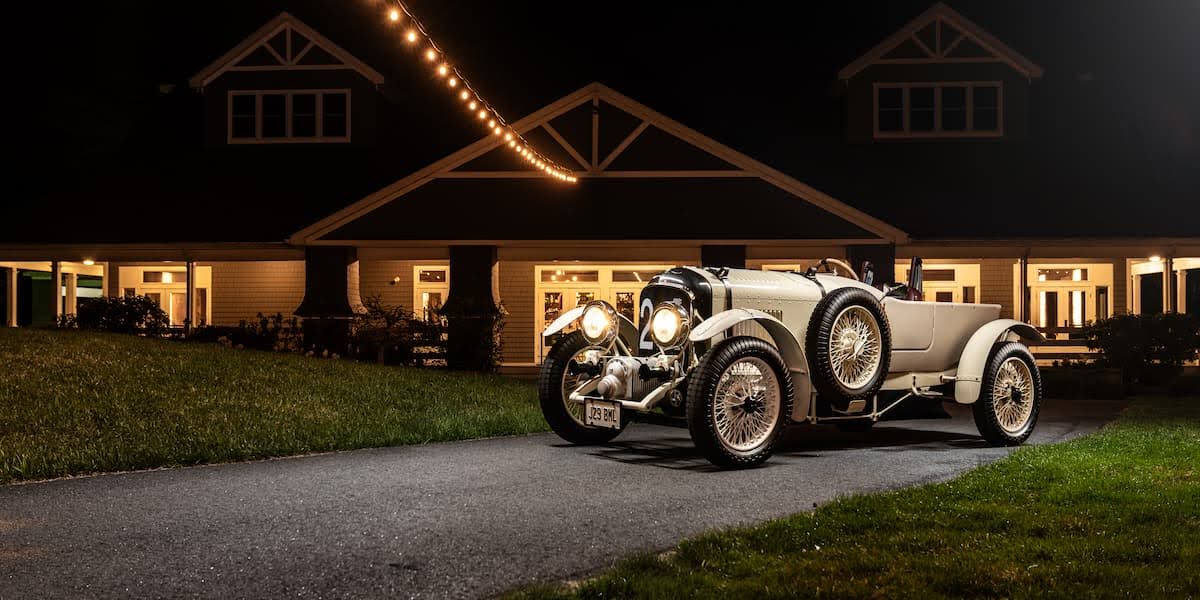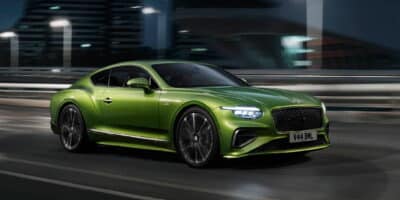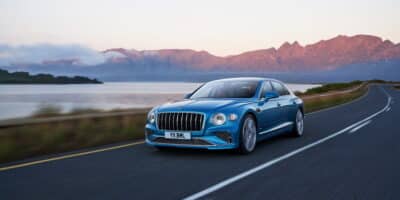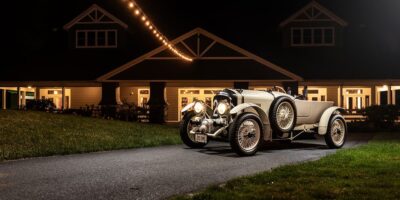When you see that unmistakable Bentley logo on the road, you know you’re looking at something special. This famous symbol – a bold letter “B” with beautiful wings spread wide – has been turning heads for over 100 years. It’s not just a pretty design; it tells an amazing story about British cars, aviation history, and what happens when someone refuses to settle for ordinary.
The Bentley logo is way more than just a brand mark. It represents everything that makes Bentley one of the world’s most respected luxury car makers. From racing victories to royal rides, this winged emblem has seen it all. Let’s dive into the fascinating story behind one of the most recognizable car logos ever created.
What makes this logo so special? Why do car enthusiasts get excited when they spot those wings? And how did a company that started by making airplane parts end up creating some of the most beautiful cars in the world? We’re about to explore all of these questions and more.
How It All Started: A Designer’s Perfect Vision
Back in 1919, Walter Owen Bentley (everyone called him W.O.) had a big dream. He wanted to build “a fast car, a good car, the best in its class.” But he knew that any great car company needed a logo that would capture people’s attention and represent what the brand stood for.
This wasn’t just about slapping any old design on a car. W.O. understood that in the luxury market, every detail matters. Your logo becomes your signature, your promise to customers, and your way of standing out in a crowded marketplace.
W.O. turned to his friend Frederick Gordon Crosby, who was already famous for drawing incredible car racing scenes for magazines like The Autocar. Crosby wasn’t just an artist – he was someone who lived and breathed the automotive world. He understood what made cars beautiful, what made them fast, and what made people’s hearts race when they saw gorgeous machines in action.
The Creative Process Behind the Winged B
Crosby faced a unique challenge. He needed to create something that would:
- Represent speed and performance
- Honor W.O.’s aviation background
- Look sophisticated and luxurious
- Be distinctive enough to avoid copycats
- Work well on everything from business cards to car hoods
After careful consideration, Crosby came up with the “Winged B” design – the letter “B” for Bentley sitting right in the middle of a pair of wings. But this wasn’t just about looking cool. Every single detail had meaning and purpose, creating a logo that would become one of the most famous symbols in the car world.
The placement was perfect. The “B” anchored the design, making it clear whose cars these were, while the wings suggested motion, freedom, and the kind of performance that could make ordinary driving feel like flying.
The Secret Behind Those Wings: A War Hero’s Story
Here’s where the story gets really interesting. Those wings on the Bentley logo aren’t just for show – they tell the story of W.O. Bentley’s incredible work during World War I.
Before he ever built a car, W.O. was busy helping Britain win the war by making airplane engines better. This wasn’t a side job or a small contribution – his work literally helped change the course of history.
The Problem That Needed Solving
Back then, fighter planes had serious problems with their engines. The cast iron pistons that most engines used were heavy and prone to problems:
- They overheated easily during intense combat situations
- They would seize up and stop working at the worst possible moments
- They made planes heavier and slower than they could be
- Pilots were losing their lives because of engine failures
W.O. had a brilliant idea while visiting a French car factory. He noticed an aluminum paperweight and thought: what if they used lightweight aluminum instead of heavy cast iron for the engine parts?
The Innovation That Changed Everything
W.O.’s aluminum pistons were a complete game-changer. They solved every major problem that pilots were facing:
- Weight reduction: Aluminum pistons were much lighter, making planes faster and more agile
- Better cooling: Aluminum conducted heat better, preventing dangerous overheating
- Improved reliability: The new pistons were less likely to fail during combat
- Enhanced performance: Pilots could push their engines harder without worry
His engines were so revolutionary that they powered the famous Sopwith Camel fighter plane. This aircraft became Britain’s most successful fighter plane of the entire war, shooting down more enemy aircraft than any other British fighter.
The impact was enormous. W.O.’s innovation helped British pilots gain air superiority and contributed significantly to winning the war. The government was so impressed they gave W.O. a special honor called the MBE (Most Excellent Order of the British Empire) and paid him £8,000 from the Commission of Awards to Inventors – money he used to start his car company.
Why This Aviation Connection Matters
So when you see those wings on a Bentley today, you’re looking at a tribute to real aviation history. The wings represent:
- Innovation under pressure: W.O. solved critical problems when lives were on the line
- Engineering excellence: His solutions worked better than anyone expected
- British ingenuity: The kind of creative thinking that built an empire
- Performance that matters: When failure isn’t an option, you need the best
The wings aren’t just decorative – they’re a promise that Bentley cars carry the same innovative spirit and commitment to excellence that helped win a world war.
Why This Car Logo with Wings Stands Out from the Rest
Walk through any car show or flip through any automotive magazine, and you’ll see plenty of winged logos. But here’s the thing – most of them are just using wings as symbols, while Bentley’s wings tell a true story.
The Difference Between Symbol and Story
Other car companies might choose wings because:
- They look fast and powerful
- They suggest luxury and prestige
- They appeal to customers’ dreams of freedom
- They stand out from non-winged competitors
But Bentley’s approach is totally different. W.O. Bentley actually worked on airplane engines. He didn’t just think wings looked cool; he lived and breathed aviation technology. That authentic connection between the company’s founder and flight makes the Bentley logo feel genuine in a way that copycat designs never could.
How Bentley’s Wings Compare to Other Famous Car Logos
Let’s look at how the car logo with wings concept plays out across different brands:
Aston Martin: Uses elegant, spread wings that suggest sophistication and British heritage. Their wings are more decorative and classical.
Chrysler: Features wide, horizontal wings that emphasize breadth and American automotive power. The design feels more industrial.
Genesis: Hyundai’s luxury brand uses wings flanking a shield, suggesting protection and premium status.
Mini: Has a small winged emblem that connects to their British heritage and suggests nimble performance.
Bentley’s wings look specifically like aviator badges – the kind that real pilots wear on their uniforms. This isn’t an accident. It directly honors W.O.’s actual experience in aviation and creates an authentic connection that other brands can’t match.
The Clever Details That Make It Special
Frederick Gordon Crosby wasn’t just a talented artist – he was also a smart businessman who understood the importance of protecting intellectual property. He knew that if Bentley’s logo became successful, other companies might try to copy it. So he built in several clever security features that most people never notice.
The Asymmetrical Secret
Here’s something fascinating: if you look closely at the Bentley logo, you’ll see that the wings don’t match exactly. Each wing has a different number of feathers! This wasn’t an accident or a mistake – Crosby did this on purpose to make the logo harder to fake.
This asymmetrical design serves several purposes:
- Anti-counterfeiting: It’s much harder to copy a design when the details aren’t symmetrical
- Quality control: Bentley could easily spot fake logos because counterfeiters usually made symmetrical versions
- Distinctiveness: The slight asymmetry makes the logo more memorable and unique
- Craftsmanship: It shows attention to detail that matches Bentley’s commitment to precision
The Hidden Engineering References
The letter “B” itself has cool details that most people miss. It sits in a black oval, and the empty spaces inside the letter look like little circles. Some people think they look like:
- Valve holes from an engine
- Piston chambers in cross-section
- Gear mechanisms
- Other mechanical elements
Whether intentional or not, these details create a subtle connection between the logo and the mechanical excellence that Bentley cars represent. It’s like having a little piece of engineering embedded right in the company’s signature.
Color Psychology and Brand Messaging
The classic black and white color scheme wasn’t chosen randomly. In color psychology:
Black represents:
- Sophistication and elegance
- Power and authority
- Exclusivity and luxury
- Timeless appeal
White represents:
- Purity and perfection
- Clarity and precision
- Premium quality
- Clean, modern design
Silver (when used) represents:
- Innovation and technology
- British aristocratic heritage
- Premium materials
- Refined taste
This color combination sends a clear message: Bentley represents the perfect balance of traditional craftsmanship and modern innovation.
From Flat Logo to Flying Sculpture: The Evolution of the Flying B
The Bentley logo started as a flat design for letterheads and business materials, but it didn’t stay two-dimensional for long. In the 1920s, wealthy car owners loved putting fancy sculptures on their car hoods. These “bonnet mascots” or “hood ornaments” were like jewelry for your car – they showed off your style and announced your arrival in unmistakable fashion.
The Golden Age of Hood Ornaments
During the 1920s and 1930s, having a distinctive hood ornament was essential for any luxury car manufacturer. These weren’t just decorations – they were status symbols that said something important about both the car and its owner.
Popular hood ornaments of the era included:
- Rolls-Royce Spirit of Ecstasy: A woman leaning forward with flowing robes
- Jaguar Leaping Cat: A sleek cat mid-leap, suggesting speed and grace
- Packard Pelican: A stylized bird representing luxury and distinctiveness
- Pierce-Arrow Archer: A Native American archer symbolizing precision and strength
Bentley needed something that would stand out in this crowded field while staying true to their aviation heritage and performance focus.
The Original Flying B Design
Bentley created the “Flying B” – a three-dimensional version of their logo that stood proudly on the front of their cars. Picture a metal sculpture of that famous “B” with wings, polished to shine in the sunlight. It was made from brass and later chrome, designed to catch light and turn heads wherever the car went.
The original Flying B had several key features:
- Upright orientation: The “B” stood tall and proud
- Detailed wings: Each feather was carefully crafted
- Premium materials: Made from the finest metals available
- Perfect proportions: Sized to complement the car’s overall design
This wasn’t just decoration – it was a three-dimensional representation of everything Bentley stood for.
The Artist Who Made It Even Better
By the 1930s, Bentley cars were getting sleeker and more modern. The upright Flying B that worked perfectly on the tall, stately cars of the 1920s looked out of place on the lower, more aerodynamic designs that were becoming popular.
The company hired Charles Sykes, the same artist who created the famous “Spirit of Ecstasy” sculpture for Rolls-Royce cars, to redesign the Flying B. This was a big deal – Sykes was considered the master of automotive sculpture.
Sykes’ Art Deco Masterpiece
Sykes created a new version that perfectly captured the Art Deco style that was sweeping through design in the 1930s:
Key features of Sykes’ design:
- Forward-leaning angle: Suggested speed and motion even when stationary
- Streamlined shape: Complemented the more aerodynamic car designs
- Faceted surfaces: Created interesting light effects as the car moved
- Readable from both sides: The “B” could be recognized from any angle
At first, Sykes tried a design with just one wing, thinking it would look more modern and streamlined. But customers didn’t like it – they wanted the familiar two-wing design that had become synonymous with Bentley. So he went back to the dual-wing concept but made it look more contemporary and elegant.
The Disappearance and Triumphant Return
The Flying B disappeared from car hoods in the 1970s because of safety rules. Governments around the world were becoming concerned about pedestrian safety, and solid hood ornaments could seriously injure people in accidents. Most car companies simply stopped using hood ornaments altogether.
But Bentley fans missed their Flying B. The flat logo was fine for business purposes, but it didn’t have the same emotional impact as seeing that three-dimensional sculpture catch the light as the car approached.
In 2006, Bentley found a brilliant solution. They brought back the Flying B with a special mechanism that could retract the sculpture into the hood when needed. This “pop-up” design meant they could have their cake and eat it too – the emotional impact of a traditional hood ornament with the safety of a modern car.
The 21st Century Redesign
In 2019, for Bentley’s 100th birthday, they decided to create a completely new Flying B design for their newest sedan, the Flying Spur. Instead of just updating the old design, they held a contest among all their designers to come up with something fresh for the company’s second century.
The winning design came from Hoe Young Hwang, and it was inspired by something unexpected: an owl. This might sound strange, but the symbolism was perfect:
Why an owl works for Bentley:
- Calm and graceful when still: Like a Bentley at rest
- Incredibly powerful in motion: Like a Bentley accelerating
- Silent flight: Like the quiet luxury of a Bentley interior
- Perfect precision: Like Bentley’s engineering standards
- Timeless wisdom: Like Bentley’s century of experience
The new design represents an owl gliding over a calm lake, with the sculpture’s widening base creating the impression of a wake on the water’s surface. It’s modern, meaningful, and maintains the connection to flight that has always been central to Bentley’s identity.
The Color Code That Tells a Story
Here’s something really cool about the Bentley logo that most people don’t know: the colors can change depending on what kind of car you’re looking at. Most people only see the classic black and white version, but Bentley actually uses different colored backgrounds to tell you about the car’s personality and intended use.
The Secret Language of Bentley Colors
This color-coding system isn’t just for show – it’s a sophisticated way of communicating with customers who understand cars. Here’s how it works:
Black Background (Most Common):
- Used for the most powerful cars that regular customers can buy
- Represents the absolute best Bentley makes for private owners
- Signifies ultimate luxury and performance
- Found on models like the Continental GT Speed and Bentayga Speed
Green Background (Racing Heritage):
- You’ll see this on racing cars and super sporty models
- Connects to British Racing Green, a traditional color in motorsports
- Honors Bentley’s incredible racing history at Le Mans
- Represents performance and competition focus
Red Background (Exclusive Limited Editions):
- This special color is saved for rare, limited-edition cars
- Only appears on vehicles that few people will ever own
- Signifies extreme exclusivity and collector value
- Often used for anniversary editions and special commemorative models
Why This System Works So Well
This color system started back in 1931, and it’s still used today. It serves several important purposes:
- Instant recognition: Car enthusiasts can immediately understand what they’re looking at
- Brand hierarchy: It clearly shows where each model fits in Bentley’s lineup
- Collector appeal: Special colors make certain models more desirable
- Heritage connection: It links modern cars to Bentley’s racing history
It’s like a secret code that car enthusiasts can read to understand what makes each Bentley special. You don’t need to study technical specifications – the logo color tells you everything you need to know about the car’s character.
A Logo That Never Gets Old: The Power of Consistency
One of the most amazing things about the Bentley logo is how little it has changed over more than 100 years. In a world where companies constantly rebrand and update their visual identities, Bentley’s consistency is remarkable and strategic.
Why Most Companies Change Their Logos
Think about how many famous logos have changed dramatically over the years:
- Apple: Went from a detailed illustration to a simple apple shape
- Pepsi: Has changed its design dozens of times
- Shell: Simplified from a detailed shell to basic geometric shapes
- McDonald’s: Evolved from complex designs to simple golden arches
Companies usually change their logos because they want to:
- Look more modern and current
- Appeal to younger customers
- Simplify for digital applications
- Distance themselves from past problems
- Follow design trends
Why Bentley Chose Consistency Instead
But Bentley took a different approach. They decided that their logo was already perfect and that changing it would actually hurt their brand. Here’s why this strategy worked:
Heritage Value: Bentley’s customers appreciate tradition and history. Keeping the same logo shows respect for the brand’s legacy.
Recognition Factor: When people see those wings, they immediately know it’s a Bentley. Changing the design would waste over 100 years of brand recognition.
Luxury Positioning: In the luxury market, consistency suggests quality and reliability. Brands that constantly change seem uncertain and unreliable.
Timeless Design: Frederick Gordon Crosby created something that transcends fashion and trends. Good design doesn’t need to change.
The Typography That Time Forgot
The “B” in the logo uses a custom typeface that was made just for Bentley over 100 years ago. This font has several distinctive characteristics:
- Bold and confident: The thick lines suggest strength and reliability
- Subtle serifs: Small decorative flourishes that add elegance
- Perfect proportions: The letter fits perfectly within the wing design
- Readable at any size: Works equally well on business cards and billboards
When the full “Bentley” name appears under the logo, it’s usually in clean, simple letters that complement the main design without competing with it.
This typographic consistency shows that Bentley values tradition and understands that some designs are simply timeless. When something is already perfect, why change it?
How Bentley Stands Out Among Car Logos with Wings
The automotive world is surprisingly full of winged logos. When you start looking for them, you’ll find wings everywhere in car design. But Bentley’s approach feels different and more authentic than most competitors.
The Psychology Behind Wings in Automotive Design
Why do so many car companies use wings in their logos? The answer lies in human psychology and our deepest desires:
Freedom and Escape: Cars represent the ability to go anywhere, and wings suggest unlimited freedom
Speed and Performance: Birds are fast, agile creatures that can outmaneuver ground-based animals
Rising Above: Wings suggest transcendence – the ability to rise above ordinary life
Power and Grace: Flying creatures combine strength with elegance in a way that appeals to luxury customers
Dreams and Aspiration: Humans have always dreamed of flight, and wings tap into those fundamental desires
What Makes Bentley’s Wings Different
While other companies use wings as symbols, Bentley’s wings tell a true story. Here’s what sets them apart:
Authentic Heritage: W.O. Bentley actually worked in aviation, so the wings aren’t just decoration
Specific Design: They look like aviator badges, not generic bird wings or abstract shapes
Historical Significance: They connect to real events that changed world history
Consistent Application: The same basic design has been used for over 100 years
Multiple Meanings: They represent both the founder’s background and the driving experience
Wings Around the World: Cultural Meanings
The Bentley logo works well in international markets because wings have positive meanings in virtually every culture:
Western Cultures: Wings represent freedom, power, and transcendence
Eastern Cultures: In China (Bentley’s largest market), wings can symbolize rising above ordinary life to achieve greatness
Religious Contexts: Most religions use wings to represent divine power and spiritual elevation
Military Traditions: Wings are associated with elite units and exceptional skill
Artistic Heritage: Wings have been symbols of beauty and grace in art for thousands of years
This universal appeal helps explain why the Bentley logo works so well in global markets.
The Digital Age: How Classic Design Adapts to Modern Needs
As our world becomes increasingly digital, the Bentley logo faces new challenges that Frederick Gordon Crosby never could have imagined. How do you make a complex, detailed design work on smartphone screens, social media profiles, and digital billboards?
Modern Logo Challenges
Today’s logos need to work in situations that didn’t exist when Bentley’s was created:
- Tiny mobile screens: The logo must be recognizable at very small sizes
- Social media profiles: It needs to work as a square or circular avatar
- Video content: It should look good in motion and video applications
- Digital billboards: Must maintain impact at massive sizes
- App icons: Needs to work in simplified, icon-style formats
Why Bentley’s Design Still Works
Surprisingly, the Bentley logo handles these modern challenges extremely well:
Strong Contrast: The black and white design shows up clearly on any background
Simple Shapes: Despite its details, the basic wing and “B” shape reads clearly at small sizes
Distinctive Silhouette: Even when you can’t see individual feathers, the overall shape is recognizable
Balanced Proportions: The design works equally well large or small
Iconic Elements: The “B” anchors the design and remains readable even when wing details disappear
The “Gen B” Evolution
Recently, Bentley introduced a simplified version of their logo called “Gen B” for some marketing materials. This streamlined version:
- Removes some of the detailed feathers for better digital reproduction
- Maintains the essential “B” and wing elements
- Works better on social media and mobile applications
- Preserves brand recognition while improving functionality
This shows that Bentley is willing to adapt their visual identity for modern needs while keeping the essential elements that make the brand recognizable.
Questions Readers Often Ask About the Bentley Logo
What does the Bentley logo mean?
The Bentley logo represents the founder’s aviation background and the company’s commitment to performance that can make driving feel like flying. The “B” stands for Bentley, while the wings honor W.O. Bentley’s work on aircraft engines during World War I.
Why do the wings have different numbers of feathers?
This was a deliberate anti-counterfeiting measure. Designer Frederick Gordon Crosby made each wing asymmetrical to make the logo harder to copy and easier for Bentley to identify fake versions.
How many car companies use wings in their logos?
Dozens of automotive brands have used wings in their logos over the years, but Bentley’s design is unique because it’s based on the founder’s actual aviation experience rather than just symbolic use of wings.
Has the Bentley logo ever changed?
The basic design has remained remarkably consistent for over 100 years. The main changes have been in the hood ornament versions and the introduction of different background colors for different car types.
What’s the difference between the flat logo and the Flying B?
The flat logo is used for business purposes, marketing materials, and badges. The Flying B is a three-dimensional hood ornament that appears on certain Bentley models as a luxury feature.
Why did Bentley stop using hood ornaments?
Safety regulations in the 1970s led to the temporary removal of solid hood ornaments. Bentley brought back the Flying B in 2006 with a retractable mechanism that meets modern safety standards.
What do the different colors mean?
Black backgrounds indicate the most powerful customer cars, green represents racing heritage, and red signifies limited editions. This color-coding system helps identify the car’s purpose and exclusivity level.
Looking Ahead: Wings for the Future
Bentley is changing with the times in exciting ways. The company has committed to making only electric cars by 2030 as part of their “Beyond100” plan for a more sustainable future. This means the Bentley logo has to work for a new generation of environmentally conscious luxury car buyers who care about both performance and planet.
Why Wings Work for Electric Cars
The good news is that wings might work even better for electric cars than they do for traditional ones:
Silent Operation: Electric cars are quiet and smooth, which makes the flying experience feel even more real
Instant Acceleration: Electric motors provide immediate power, creating a sensation of taking off
Environmental Connection: Wings suggest harmony with nature, which appeals to eco-conscious buyers
Future Technology: Wings represent advancement and innovation, perfect for cutting-edge electric vehicles
Effortless Motion: Electric driving feels smooth and effortless, just like soaring through the sky
Bentley’s Electric Future
Bentley isn’t just making electric cars – they’re reimagining what luxury electric vehicles can be:
- Beyond100 Manifesto: Their commitment to becoming the world’s most sustainable luxury automotive brand
- Carbon Neutral Goal: Planning to achieve carbon neutrality across their entire operation
- Renewable Energy: Their UK factory already runs partly on solar power
- Innovative Materials: Exploring sustainable alternatives to traditional luxury materials
- Advanced Technology: Integrating the latest electric powertrains with traditional craftsmanship
The Bentley logo will play a crucial role in communicating these changes to customers while maintaining connection to the brand’s heritage.
Recent Developments and Future Plans
Recent innovations show how Bentley is adapting their brand for the future:
Gen B Logo: A simplified version for digital applications that maintains brand recognition
New Flying B Design: The owl-inspired 2019 redesign shows willingness to evolve while honoring tradition
Sustainable Branding: Marketing materials increasingly emphasize environmental responsibility alongside luxury
Global Expansion: The logo works well in international markets, especially the crucial Chinese market
Technology Integration: The logo appears in digital displays and infotainment systems throughout modern Bentley vehicles
The Enduring Legacy of Winged Excellence
The Bentley logo represents something rare in today’s world: a commitment to excellence that doesn’t compromise. From W.O. Bentley’s innovative work on airplane engines that helped win World War I to today’s handcrafted luxury cars that blend traditional skills with modern technology, those wings connect past achievements with future possibilities.
This isn’t just about nostalgia or tradition for its own sake. The values that the logo represents – innovation, quality, performance, and attention to detail – are exactly what luxury car buyers want today. Whether they’re choosing a traditional gasoline engine or the latest electric powertrain, customers want vehicles that represent the absolute best that money can buy.
As one of the most famous car logos with wings, Bentley’s emblem continues to inspire people who understand that true luxury comes from doing things the right way, not just the easy way. The wings that Frederick Gordon Crosby designed over a century ago still represent the same promise: that some brands don’t just make cars – they create experiences that lift you above the ordinary.
What Makes Bentley Special Today
In a world full of luxury car choices, the Bentley logo helps communicate what makes this brand different:
- Handcrafted Excellence: Every Bentley is still built by skilled artisans in Crewe, England
- Performance Heritage: Racing victories at Le Mans and other prestigious events
- Royal Approval: Bentley cars have been chosen by the British Royal Family for decades
- Innovation Leadership: Constantly pushing boundaries in luxury automotive technology
- Sustainable Luxury: Leading the industry toward environmentally responsible luxury
- Global Recognition: The winged logo is respected and recognized worldwide
A Symbol That Transcends Time
For anyone who appreciates the combination of heritage and innovation, performance and luxury, the Bentley logo represents a promise that never gets old. Whether you see it on a Continental GT speeding through mountain curves or on a Bentayga navigating city streets, those wings represent the pursuit of automotive perfection that started in a small London workshop over 100 years ago.
The logo tells a story that begins with a young engineer who thought aluminum might make airplane engines better and continues today with craftspeople who hand-stitch leather interiors and polish wood veneers to perfection. It’s a story about refusing to accept “good enough” and always reaching for something higher.
In a world where many brands throw away their history to chase trends, Bentley’s commitment to preserving and honoring its iconic winged emblem shows that true luxury comes from respecting the past while boldly moving toward the future. The Bentley logo proves that when design tells an authentic story, it becomes more than just a symbol – it becomes a legacy that can inspire people for generations.
When you see those wings today, you’re not just looking at a car company’s logo. You’re seeing a symbol that represents the human desire to exceed limitations, to create something beautiful and meaningful, and to never stop reaching for the sky. That’s why the Bentley logo remains one of the most powerful and respected emblems in the automotive world, and why it will continue to inspire car enthusiasts for another century to come.
Ready to experience the legacy behind the wings? Visit Braman Bentley of Palm Beach to discover how Bentley’s commitment to handcrafted excellence and innovative engineering continues to set new standards in luxury automotive design, and explore the stunning vehicles that proudly display this iconic emblem.






